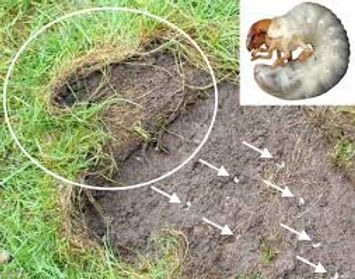

What Are Lawn Grubs?
Lawn grubs — also known as white grubs — are small, white creatures that curl up into a distinctive C shape when disturbed. They are the larval form of several types of scarab beetles, including Oriental beetles, Japanese beetles, chafer beetles and green June beetles.
When lawn grubs are active in an area, you can find them a couple of inches below the surface of the soil. As winter approaches, they burrow deeper, between 4 and 8 inches beneath the surface.
Grubs typically damage lawns by feeding on grass roots. They develop into beetles, which damage foliage and flowers as they feed. Female beetles lay eggs in the lawn and the eggs hatch into grubs during the summer. The young grubs begin feeding and continue into the fall, when they do the most damage. They become inactive as winter approaches, but become active and begin feeding again in the spring. The life cycle of most scarab beetles is one year.
Evidence of Grubs in the Lawn
There are several types of damage in the lawn that may indicate grubs. Brown patches that don't green up in the spring may be the result of grubs feeding the previous fall. In late summer and fall, randomly shaped dead patches may indicate grubs. Birds, raccoons, skunks, moles and other small animals may tear up areas of your lawn at night looking for grubs. Turf that feels spongy or that lifts up easily to reveal damaged roots or no roots at all may be evidence of grub damage.
These symptoms can also signify other lawn conditions. Checking the soil for grubs is the only way to confirm that your lawn has grubs and determine if they are a problem. Make cuts 6 to 12 inches long and about 3 inches deep on three sides of a patch of grass. Peel back the turf and look for grubs. Check several areas and estimate the number of grubs per square foot in the lawn. Once you've finished checking for grubs, replace the turf.
Five or fewer grubs per square foot are not a problem for a healthy lawn. If you find six or more per square foot, you may want to treat the most visibly damaged areas of your lawn. You may also want to get rid of the grubs if animals are digging up your lawn looking for them. Ten or more grubs per square foot will likely cause noticeable damage and require treatment.
Good to Know
Beetles flying over your lawn or a neighbor's lawn during the summer may be a hint that you'll find grubs later in the year. A well-watered, unshaded lawn can invite grub activity. There will be a better chance that beetles will lay eggs and grubs will develop in moist soil.
